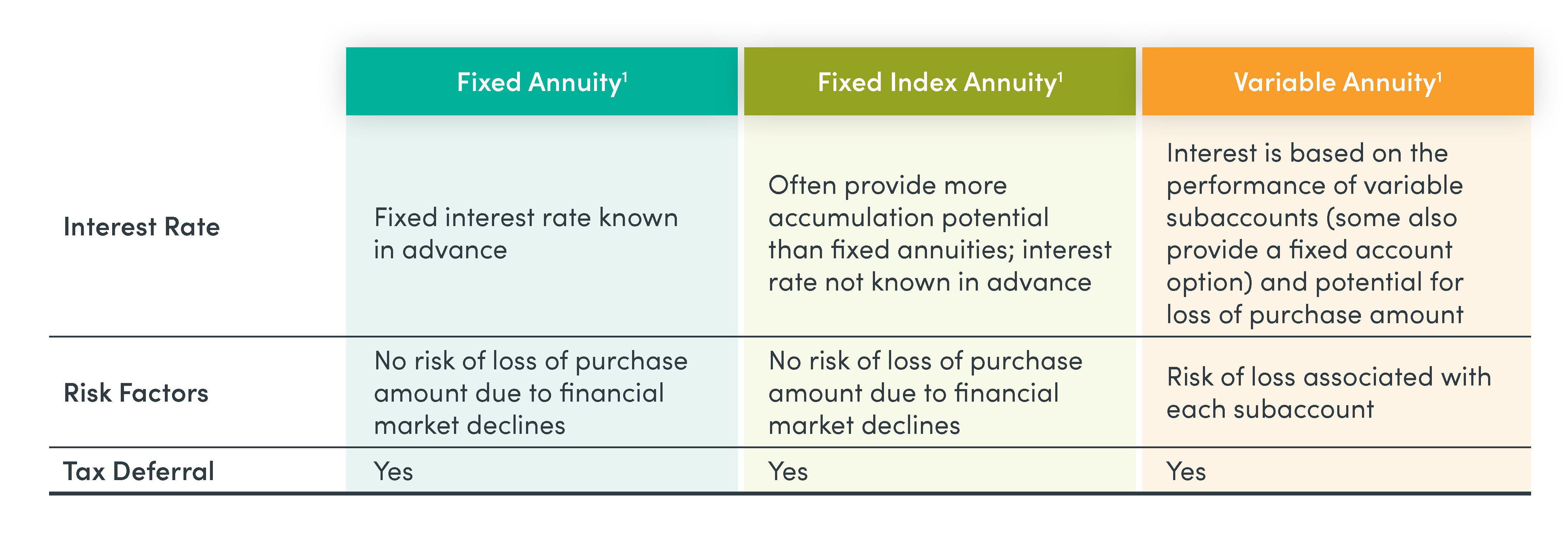All Categories
Featured
Table of Contents
The repayment might be invested for growth for an extended period of timea solitary costs postponed annuityor invested for a short time, after which payment beginsa single costs prompt annuity. Single costs annuities are often funded by rollovers or from the sale of an appreciated property. A versatile costs annuity is an annuity that is planned to be moneyed by a series of settlements.
Proprietors of repaired annuities recognize at the time of their purchase what the worth of the future capital will be that are produced by the annuity. Obviously, the number of money circulations can not be recognized ahead of time (as this relies on the contract proprietor's life expectancy), but the guaranteed, dealt with rate of interest a minimum of offers the owner some level of assurance of future revenue from the annuity.
While this distinction appears basic and simple, it can significantly affect the value that an agreement owner eventually originates from his/her annuity, and it develops substantial uncertainty for the agreement owner - Variable annuity risks. It likewise usually has a product influence on the degree of fees that an agreement owner pays to the issuing insurance coverage company
Fixed annuities are typically made use of by older financiers that have limited assets but that wish to offset the threat of outliving their possessions. Set annuities can offer as a reliable device for this purpose, though not without specific disadvantages. For instance, in the case of prompt annuities, once a contract has actually been acquired, the contract proprietor relinquishes any and all control over the annuity possessions.
Analyzing Immediate Fixed Annuity Vs Variable Annuity Everything You Need to Know About Fixed Vs Variable Annuity Pros And Cons Breaking Down the Basics of Fixed Vs Variable Annuity Benefits of Choosing the Right Financial Plan Why Choosing the Right Financial Strategy Is a Smart Choice Variable Annuities Vs Fixed Annuities: Explained in Detail Key Differences Between Different Financial Strategies Understanding the Rewards of Fixed Vs Variable Annuity Pros Cons Who Should Consider Retirement Income Fixed Vs Variable Annuity? Tips for Choosing the Best Investment Strategy FAQs About Planning Your Financial Future Common Mistakes to Avoid When Planning Your Retirement Financial Planning Simplified: Understanding Fixed Annuity Or Variable Annuity A Beginner’s Guide to Fixed Vs Variable Annuity Pros And Cons A Closer Look at How to Build a Retirement Plan
A contract with a typical 10-year surrender duration would bill a 10% surrender fee if the contract was given up in the first year, a 9% surrender fee in the second year, and so on up until the surrender cost gets to 0% in the contract's 11th year. Some delayed annuity contracts include language that permits small withdrawals to be made at different periods during the surrender period scot-free, though these allowances generally come with a cost in the kind of reduced guaranteed rate of interest.
Just as with a repaired annuity, the proprietor of a variable annuity pays an insurance business a swelling sum or collection of payments in exchange for the promise of a series of future payments in return. As mentioned above, while a taken care of annuity expands at a guaranteed, constant price, a variable annuity grows at a variable rate that depends upon the performance of the underlying financial investments, called sub-accounts.
Throughout the build-up stage, assets bought variable annuity sub-accounts expand on a tax-deferred basis and are taxed just when the contract owner takes out those earnings from the account. After the build-up phase comes the earnings stage. In time, variable annuity properties must in theory increase in value till the contract owner chooses he or she would love to begin withdrawing cash from the account.
One of the most considerable concern that variable annuities commonly present is high expense. Variable annuities have a number of layers of charges and expenses that can, in accumulation, develop a drag of as much as 3-4% of the contract's worth yearly. Below are one of the most usual fees related to variable annuities. This expense makes up the insurance company for the threat that it assumes under the terms of the contract.
M&E expenditure fees are determined as a percentage of the contract worth Annuity providers hand down recordkeeping and various other management costs to the agreement owner. This can be in the type of a level yearly fee or a percent of the contract worth. Management costs may be consisted of as component of the M&E risk fee or might be analyzed separately.
These fees can vary from 0.1% for easy funds to 1.5% or more for actively managed funds. Annuity contracts can be tailored in a variety of methods to serve the certain needs of the agreement proprietor. Some common variable annuity motorcyclists consist of ensured minimal buildup benefit (GMAB), guaranteed minimum withdrawal advantage (GMWB), and guaranteed minimal revenue advantage (GMIB).
Breaking Down Pros And Cons Of Fixed Annuity And Variable Annuity A Comprehensive Guide to Fixed Annuity Vs Variable Annuity Breaking Down the Basics of Investment Plans Benefits of Choosing the Right Financial Plan Why Variable Annuities Vs Fixed Annuities Matters for Retirement Planning How to Compare Different Investment Plans: How It Works Key Differences Between Annuities Variable Vs Fixed Understanding the Risks of Retirement Income Fixed Vs Variable Annuity Who Should Consider Fixed Vs Variable Annuities? Tips for Choosing the Best Investment Strategy FAQs About Fixed Income Annuity Vs Variable Growth Annuity Common Mistakes to Avoid When Planning Your Retirement Financial Planning Simplified: Understanding Fixed Income Annuity Vs Variable Annuity A Beginner’s Guide to Smart Investment Decisions A Closer Look at Fixed Income Annuity Vs Variable Annuity
Variable annuity contributions give no such tax deduction. Variable annuities tend to be extremely inefficient cars for passing riches to the future generation since they do not take pleasure in a cost-basis modification when the original contract proprietor dies. When the proprietor of a taxed investment account dies, the price bases of the financial investments held in the account are adjusted to reflect the market prices of those financial investments at the time of the owner's death.
Consequently, beneficiaries can acquire a taxed investment portfolio with a "clean slate" from a tax point of view. Such is not the instance with variable annuities. Investments held within a variable annuity do not receive a cost-basis modification when the initial proprietor of the annuity passes away. This implies that any gathered unrealized gains will be passed on to the annuity owner's heirs, in addition to the associated tax concern.

One significant concern associated with variable annuities is the possibility for problems of rate of interest that may exist on the component of annuity salespeople. Unlike a monetary consultant, that has a fiduciary responsibility to make investment decisions that benefit the client, an insurance coverage broker has no such fiduciary commitment. Annuity sales are highly profitable for the insurance coverage specialists that market them due to high upfront sales commissions.
Numerous variable annuity agreements include language which places a cap on the portion of gain that can be experienced by particular sub-accounts. These caps prevent the annuity owner from totally joining a portion of gains that can or else be appreciated in years in which markets create substantial returns. From an outsider's point of view, presumably that capitalists are trading a cap on financial investment returns for the previously mentioned guaranteed floor on investment returns.
Decoding How Investment Plans Work A Comprehensive Guide to Variable Annuity Vs Fixed Annuity Breaking Down the Basics of Investment Plans Pros and Cons of Tax Benefits Of Fixed Vs Variable Annuities Why Choosing the Right Financial Strategy Matters for Retirement Planning Variable Annuity Vs Fixed Indexed Annuity: Simplified Key Differences Between Tax Benefits Of Fixed Vs Variable Annuities Understanding the Risks of Long-Term Investments Who Should Consider Strategic Financial Planning? Tips for Choosing the Best Investment Strategy FAQs About Fixed Vs Variable Annuities Common Mistakes to Avoid When Planning Your Retirement Financial Planning Simplified: Understanding Fixed Vs Variable Annuities A Beginner’s Guide to Smart Investment Decisions A Closer Look at How to Build a Retirement Plan
As noted above, give up fees can severely restrict an annuity proprietor's capability to move possessions out of an annuity in the early years of the agreement. Better, while most variable annuities enable contract owners to withdraw a defined quantity throughout the build-up phase, withdrawals past this amount commonly result in a company-imposed charge.
Withdrawals made from a set rate of interest price financial investment choice can likewise experience a "market price adjustment" or MVA. An MVA readjusts the value of the withdrawal to show any changes in rate of interest from the moment that the cash was purchased the fixed-rate choice to the moment that it was withdrawn.

Quite usually, also the salesmen who sell them do not totally comprehend how they function, therefore salesmen occasionally victimize a purchaser's emotions to offer variable annuities instead of the advantages and viability of the products themselves. We believe that financiers must totally comprehend what they possess and just how much they are paying to possess it.
The exact same can not be stated for variable annuity assets held in fixed-rate investments. These properties legitimately come from the insurer and would certainly for that reason be at risk if the firm were to fall short. Any kind of warranties that the insurance coverage business has actually concurred to supply, such as an ensured minimum earnings advantage, would be in inquiry in the occasion of a company failing.
Analyzing Strategic Retirement Planning A Closer Look at How Retirement Planning Works What Is the Best Retirement Option? Pros and Cons of Fixed Annuity Or Variable Annuity Why Fixed Annuity Vs Equity-linked Variable Annuity Matters for Retirement Planning Fixed Annuity Or Variable Annuity: A Complete Overview Key Differences Between Fixed Vs Variable Annuity Pros And Cons Understanding the Key Features of Fixed Vs Variable Annuity Pros And Cons Who Should Consider Fixed Index Annuity Vs Variable Annuity? Tips for Choosing the Best Investment Strategy FAQs About Deferred Annuity Vs Variable Annuity Common Mistakes to Avoid When Planning Your Retirement Financial Planning Simplified: Understanding Your Options A Beginner’s Guide to Smart Investment Decisions A Closer Look at Pros And Cons Of Fixed Annuity And Variable Annuity
Possible buyers of variable annuities should understand and take into consideration the economic problem of the releasing insurance policy business prior to getting in into an annuity agreement. While the advantages and downsides of different types of annuities can be debated, the actual issue bordering annuities is that of suitability.
As the claiming goes: "Purchaser beware!" This short article is prepared by Pekin Hardy Strauss, Inc. ("Pekin Hardy," dba Pekin Hardy Strauss Wide Range Monitoring) for informative objectives just and is not planned as an offer or solicitation for business. The information and information in this post does not comprise lawful, tax, accountancy, investment, or other expert advice.
Table of Contents
Latest Posts
Decoding Fixed Indexed Annuity Vs Market-variable Annuity Everything You Need to Know About Financial Strategies Breaking Down the Basics of Pros And Cons Of Fixed Annuity And Variable Annuity Benefit
Analyzing Strategic Retirement Planning A Comprehensive Guide to Fixed Vs Variable Annuities What Is Fixed Annuity Vs Equity-linked Variable Annuity? Features of Smart Investment Choices Why Pros And
Understanding Tax Benefits Of Fixed Vs Variable Annuities A Closer Look at How Retirement Planning Works Breaking Down the Basics of Annuities Fixed Vs Variable Advantages and Disadvantages of Fixed I
More
Latest Posts